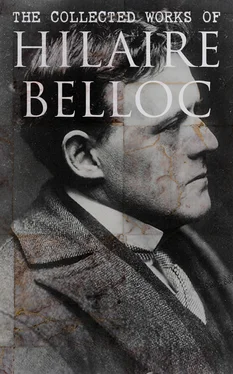At the close of this section the plainest duty of an historian, as well as the satisfaction of common humour, compels me to allude to a characteristic production of the University of Oxford. There has proceeded from this university a school-book, perhaps the most universally used in the public schools of this country, known as Bright’s History of England . I was myself brought up on it. It is taken, I suppose (like much other Oxford matter), as something hall-marked and official. This text-book has upon page 226 of its first volume a full-page map of the Battle of Crécy. It is fair to say that such a production could not have proceeded, I do not say from any university upon the Continent of Europe, but from the humblest schoolmaster in a French, Swiss, or German village. The features marked upon it are wholly and unreservedly imaginary. There is not even the pretence of a remote similarity between this grotesque thing and the terrain of the famous battle: it is a pure invention. It is almost impossible to express in words the difference between this product of fancy, and even the most inaccurate map sketched from memory, or the merest jottings set down by someone who had no more to guide him than some vague recollection of an account of the battle. There is nothing in it bearing the remotest resemblance to any hill, river, road, wood, village, or point of the compass concerned with the field of Crécy, and to this astonishing abortion is modestly added in the left-hand bottom corner, “From Sprüner.” I have not by me as I write Sprüner’s collection of historical maps which were given us at the University, but if that eminent authority was the model for such a masterpiece, it is a sufficient commentary upon the rest of his work. I have before me as I write the flabbergasting plan in Bright’s History which I have treasured ever since my boyhood, and I trust that this note may be read by many who still believe that the function of our universities is to train the governing class of the nation, not so much in learning as in “character.”
Contrast the excellent and accurate little map in the first-rate manual which Mr. Barnard published twelve years ago from the Clarendon Press. The whole of this book is to be most highly recommended. I believe that this map, the only doubtful features of which are the angular formation of the English Archers and the concentration of the French rear upon the Roman road, is from the pencil of Mr. Oman.
Table of Contents
King Edward, upon that Saturday morning before he had yet caught sight of the French, of whose advance his scouts informed him, rode on a little horse slowly up and down the ranks encouraging his army, as it sat and lay at rest, with shield and helm and bow upon the grass before each man, along the crest of the slight hill.
In his hand the King bore a white wand and no weapon, and this visitation of his lasted until nearly ten o’clock. His last orders were that all his men should eat and drink heartily, and he himself conveyed that order to his own division, which lay behind the main line. He had organised the defence upon a very simple pattern.
That battalion which was called the First Battalion consisted of 1200 men-at-arms, that is, fully armoured knights upon horseback, with 4000 Archers and 4000 Welshmen. They occupied that turn or shoulder of the slope which runs round from the town of Crécy itself into the beginning of the Val aux Clercs, and were under the nominal command of the lad the Prince of Wales. But at his side the real orderers of that force were Warwick and Oxford. Such was the English right.
Next, in the centre, and back from the first battalion, was the line of English Archers. It was very carefully organised, with the object of a purely defensive action. Small pits were dug before each man’s station, and this infantry was arranged in “harrow” formation, much as trees are planted in an orchard in quincunx , so that any five of them formed a figure somewhat like the five in a pack of cards. It is evident that this formation, if the men were sufficiently dispersed, as they were, gave the freest play to their missiles, all of which could be shot through the intervals; and when we remember the rate of fire, three to one of the cross-bow, we shall understand how formidable was this infantry, and how well able it was to break any cavalry charge prepared by nothing more than the shots of the Genoese. All the tradition and sentiment of medieval warfare gave to the mounted knight the glory of battle, but, as I shall have occasion to remark in the sequel, the great feature of Crécy was the presence of an ordered, highly trained infantry, expected to await, and capable of awaiting, a rush of horse until that cavalry should receive at, say, fifty to eighty yards the whole weight of a furious and sustained discharge of missiles. Beyond the Archers, some 3000 in number at this point, were 1200 mounted knights, who, together with the Archers at the centre, were under the command of Northampton.
There may have been a certain number of Archers to the left again of these knights, but, at any rate, Northampton’s command covered the rest of the ridge and reposed upon Wadicourt. Here, lest it should be turned, the left flank of the English line was protected by a park of wagons drawn up close together, vehicles taken from such of the train as had been saved from the French attack upon the rearguard at the ford two days before.
The remainder of the wagons, provisions, and impedimenta were drawn up in the rear near the wood, and in front of them and between them and the defensive line upon the ridge was a strong reserve of over 10,000 men under Edward himself. Taking no account of non-combatants, we must reckon Archers, armoured men and spear-men together at perhaps 25,000 men, and certainly not more than 30,000; but we must remember, as I said upon a former page, that every Archer was served by aides, that a man-at-arms needed a squire, and that drivers and domestics of various kinds, and many recruits from Normandy, swelled the host.
The large force against which this defensive was drawn up has been variously estimated. Its dispersion over the countryside, the lack of any cohesive command, the absence of all precise figures, the considerable bodies of wholly untrained country folk who were straggling up behind the army, make an estimate of the actual forces engaged on the French side extremely difficult. We do not know how many Germans, Luxemburgians, and others had been brought up with the feudal levy. The rough guess of contemporaries at the whole numbers present and arriving during this confused marshalling of Philip’s host, calls it 100,000. A recent and very careful English authority has estimated the enemy actually in line at 60,000. If we say that Edward met forces more than double his own, but not three times his own, we are as near the truth as we can hope to get. But the right way to estimate the disproportion between the offensive and the defensive upon this famous day is to contrast the fully armoured mounted men of either side, and, further, to contrast
1. The trained infantry, armed with missile weapons.
2. The infantry, trained or untrained, armed only with spear, dagger, or sword.
Upon such an analysis we get some such result as follows:—
Some 4000 fully armoured mounted men in Edward’s command, of whom only 3000 or less were out of the reserve and in the line. Some 7000 Archers actually in the defensive line, with a much smaller number (unknown) in the reserve. Add 4000 Spearmen, for the most part Welsh. Against these on the offensive you may set, at the very least, quite four times their number of fully mounted armoured men and probably six times their number, or even more. As against the English Archers, we must count for the missile arm upon the French side somewhat less. The only contemporary authority, Villani, who gives us any exact figures, names 6000 as their number.
Читать дальше












